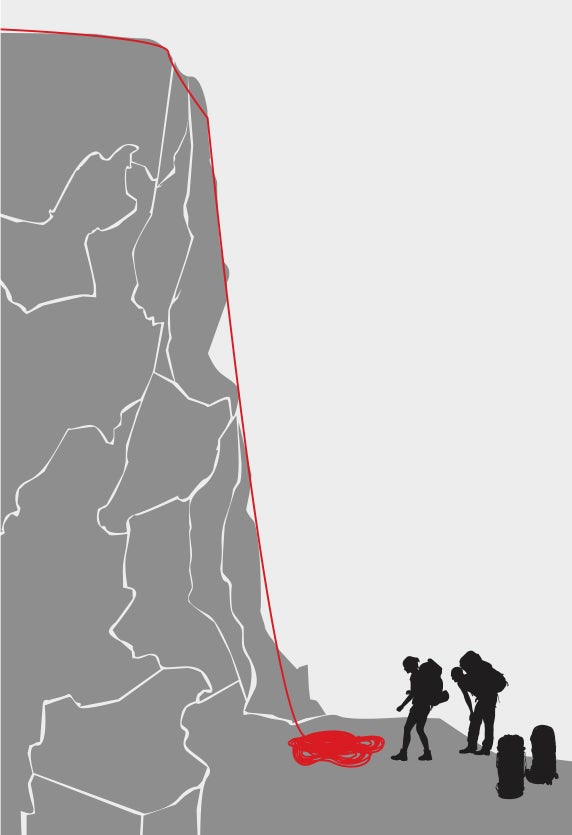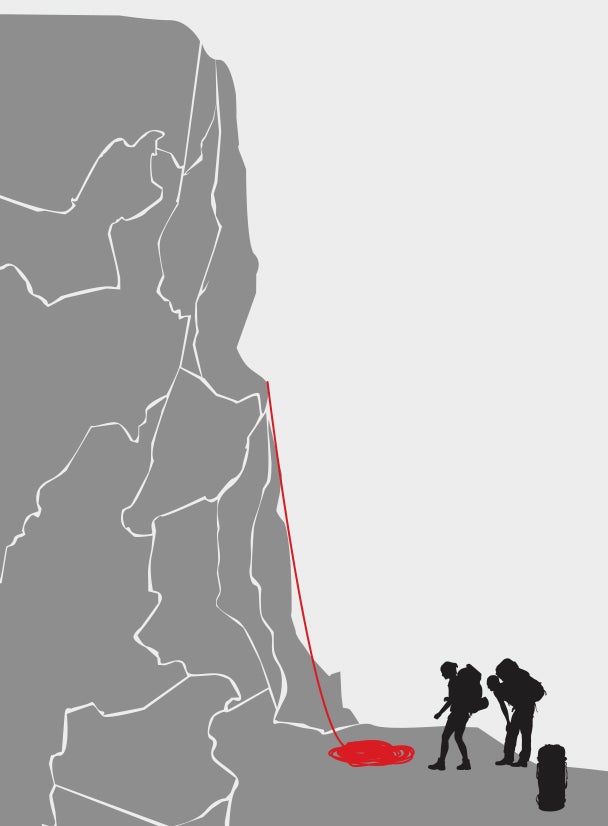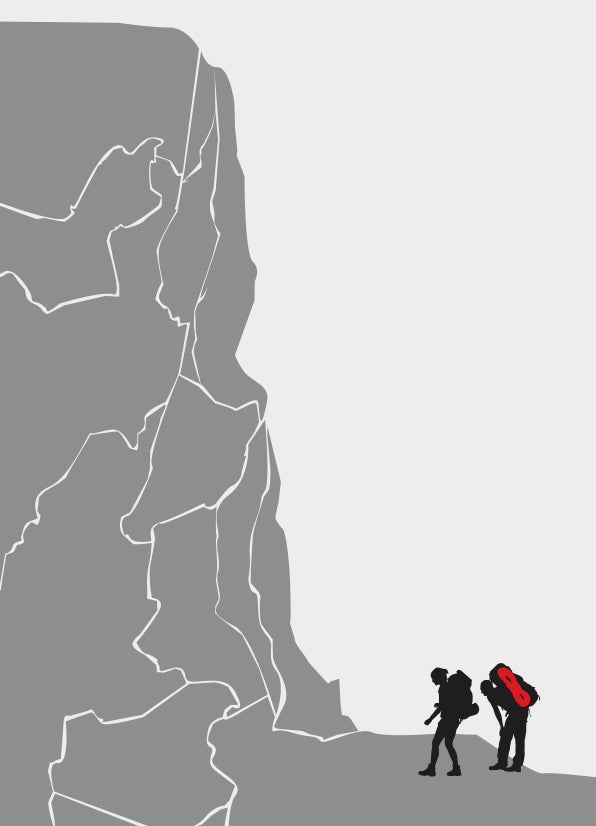Are You Choosing the Right Big Wall Strategy?

Hanging in space high above the Yosemite Valley floor on the West Face of the Leaning Tower, I was terrified, but in learning the true meaning of exposure, I got addicted to big walls. Over the next 15 years, I traveled around the world for those soaring faces, nabbing about 50 big wall routes and learning the ins and outs of the planning, ability, and equipment required. The biggest lesson I learned was how to choose a strategy that best suited the situation, which depends on the goals of the climb, the weather, time constraints, and the motivation of the parties involved. Undertaking a 1,000-foot wall in Zion, the half-mile-high monoliths in Yosemite, or the enormous cliffs of Baffin Island requires a serious plan of attack, and the right approach will significantly improve your chance of success.
Siege Style

Hundreds of feet of rope often hang on the hardest big wall routes for days, weeks, and sometimes months. On the first ascent of the Nose of El Capitan, Warren Harding and his revolving team climbed sections of the wall, hung ropes, and then retreated to the ground. They would then return, ascend to their high point, and push the ropes a bit higher, adding more rope as they moved up the wall. In 38 days of climbing, spread out over a year and a half, they pushed their ropes two-thirds of the way up the 3,000-foot wall. In late November 1958, they prusiked up 1,900 feet of fixed ropes and cast off to climb the last 1,000-plus feet over the course of nine days.
The style of using massive amounts of fixed ropes and slowly ascending a wall is referred to as sieging. This style is more common in the Himalaya and rare in places where big walls are more well-traveled, except in the cases of difficult climbs. Tommy Caldwell and Kevin Jorgeson employed this method on the Dawn Wall, fixing all of El Capitan at different points in their seven-year battle to free climb the wall. This allowed them to focus on working the crux pitches, ferrying supplies up the wall with less effort, and having a few cameramen on point. Caldwell removed ropes from the wall seasonally, rapping El Capitan and replacing the ropes when they wanted to work the route again. At the time of their free ascent, nearly 5,000 feet of rope hung from the cliff.
This is a great approach for climbers who enjoy just being on a wall. Think hauling a grill halfway up Washington Column for some wall steaks. Bring a pirate flag, a few bottles of wine, and a laid-back attitude. Even though you’ll be able to wall party, this style gets a significant amount of heckling. Royal Robbins gave Harding endless flack for his prolonged attempts. Sieging walls will have other climbers asking you what’s taking so long and bumming a few of your 50 cans of malt liquor.
Leaving fixed ropes on routes for prolonged periods can also present a serious hazard. Exposed to the elements, the ropes can become damaged very quickly, so it’s important to pay attention to what they might have undergone while hanging, including abrasion. Also be aware of leaving knots tied, as having bends in the rope can accelerate wear in that area.
Pros
- High success rate as the team can wait for a good weather window and make slow and steady progress.
- The style is popular on difficult free climbs as it allows first ascensionists to rebolt sections, work sections on rope-solo, and generally prep a route to be free climbed.
- There is less work on any individual day.
- Having an umbilical cord to the ground aids a quick retreat in the case of injury, incoming weather, or a desperate need for a wobbly pop at the bar.
Cons
- On popular routes, fixing lines can be a serious faux pas. Climbing around and through fixed ropes can be extremely difficult.
- Cords left hanging on the wall for extended periods of time can wear against the rock and get seriously damaged by the weather.
- This style requires a lot of rope. Climbers often gather old lead lines and static lines and might use in excess of 1,000 feet of rope.
- The total amount of work over the course of the ascent is significantly more but spread out over a longer time period.
- Consistent partners can be difficult to find for this style of climbing.
Fix and Blast

In September 1964, El Capitan saw its second ascent when Chuck Pratt, Tom Frost, and Royal Robbins climbed the Salathe Wall. “Although the first ascent of the Nose had required a prolonged siege with thousands of feet of fixed ropes, we wished to avoid such methods if possible so as to keep the element of adventure high with at least a moderate amount of uncertainty,” wrote Robbins in the 1974 book Vertical World of Yosemite. Robbins climbed 900 feet up to Lung Ledge, just above Heart Ledge. He fixed ropes and a few days later committed to the wall, jumaring back up and then tossing his lines to the ground. The team topped out after six days on El Capitan.
Many climbers use this method for wall routes. Climbers attempting the Nose will climb the first four pitches to Sickle Ledge and fix 400 feet of rope to the ground. After hauling to the ledge, parties sometimes rest a day and then blast up the wall. On the Salathe, a highway of six ropes leads to Heart Ledge. Climbers often climb to this high point, haul their bags up the fixed ropes, rest, and then blast up the wall. This allows for teams to get a handle on the climbing, the weather, and a jump-start on the wall without fully committing or needing miles of rope.
Pros
- This style allows climbers to bring haulbags and supplies high on the wall before committing, meaning they can stage everything in preparation for a push to the summit.
- There is only a moderate amount of daily work the first few days, giving the climbers a sense of their objective and more rest days on the ground.
- Having a few pitches fixed provides a psychological benefit, as there is less climbing from the top of the ropes to the summit.
- Climbers can wait for good weather before committing.
Cons
- While this doesn’t require as many ropes as climbing a route siege style, most climbers fix their haul line, lead line, and sometimes additional ropes, dropping the extra ropes when they blast, retrieving them later. The added cords can be a hassle.
- Rescues become more difficult once committed to the wall. There’s no good way to retreat other than rappelling.
- On popular routes, climbers use fixed ropes to jump in front of other parties, which can lead to traffic jams.
Alpine Style

The gold standard of big wall climbing, alpine style means leaving the ground and climbing to the summit without fixing ropes in advance. Over the course of nine days in October 1964, Royal Robbins, with Tom Frost, Chuck Pratt, and Yvon Chouinard, climbed the North American Wall on the southeast face of El Capitan. They shunned the use of fixed lines. “Well, we wanted an adventure, and climbing the southeast face of El Capitan without umbilical cords would be one sure way to have one,” wrote Royal Robbins years later. The team climbed without knowing if they could reach the top.
While topos and modern information have toned down the unknown adventure of most big walls, committing to the wall can still be a daunting experience; it forces a climber to learn the systems and be confident. It improves competency by teaching climbers when to move fast and when to bail. Alpine style ascents takes a sink or swim approach to the mountains. The advantage of the style is that alpine ascents it translates to faster ascents and less time on the wall, and being on the wall for less time tends to be safer because there’s a smaller chance of encountering bad weather or missing out on happy hour at the Mountain Room Bar.
Pros
- High adventure. Being committed to a wall can be very exciting.
- There’s far less work involved. The ascents tend to be much faster because less gear is brought, with less time fixing ropes, deciding how high to fix, tossing ropes, and collecting them.
- Parties climbing routes in a day will have significantly less gear because they do not need bivy equipment, extra food, and tend to climb with lighter racks. This makes climbing easier and faster.
- Royal Robbins gives congratulatory nods for alpine-style ascents.
Cons
- There’s a large amount of danger. Like fixing and blasting, once on the wall, an accident spells trouble. Climbers need to be competent enough to self-rescue.
- The increased level of commitment usually means that the route is less difficult than what someone’s maximum might be.
- If another team has fixed on the route, they can jump ahead of alpine-style climbers by jugging past them on fixed lines, which can add unexpected wait times.
- Finding partners willing to “just go for it” can be difficult.
The post Are You Choosing the Right Big Wall Strategy? appeared first on Climbing.

